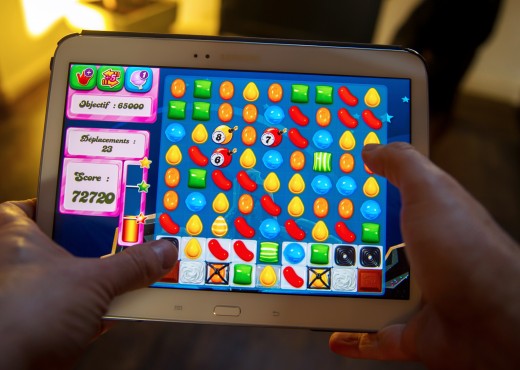
What happens when an organic form of existence, after evolving for millions of years, meets the last word in planned and designed addictiveness? Darwin goes searching for the gas pedal in this evolutionary phenomenon of his.
Smartphones have turned tens, if not hundreds, of millions of people around the world into players of videogames such as Angry Birds, Temple Run, or Candy Crush. But as the games made their way to everyone’s pocket, reports of addiction to them also escalated.
The official position of the American Psychiatric Association is that sufficient data does not yet exist for determining whether a true addiction is involved. But today reports are already widespread of mothers who were too engrossed in playing Candy Crush to remember to pick their children up from kindergarten, and many people testify that they feel addicted to casual games.
A survey by Ask Your Target Market found, among other things, that 28 percent play during work, 10 percent have found themselves arguing with their near ones about wasting time on playing, and 30 percent consider themselves addicted.
What exactly gives these games such a dramatic influence over people?
How does crushing candy differ from old-fashioned games?
In contrast to childhood games that involved human partners, or at least involved manipulating real objects in real space, smartphone games require nothing. A central part of the expected gratification in old-fashioned games was deciding which game to play this time and making preparations (setting out the playing pieces, arranging the dollhouse, assigning characters, or determining who takes the first turn).
Even videogames for computers and for consoles are an entirely different matter from smartphone games. In videogames, we generally assume a masterful role such as superhero, soccer player, warrior, or the like, fulfilling a fantasy and giving our senses and emotions an experience.
Such games boost adrenaline levels, and they awaken strong feelings of power as well as frustration, gratification, and enjoyment.
Playing smartphone games does not result from a desire to take part in any shared activity or to achieve any fantasy. Their gratification derives from a change of mental state, a sort of detachment. To select the app and start the game, no investment is required, no thought or intention, but merely the urge to play.
The urge appears just as hunger or thirst does. Like them, it requires no handling in depth and no thought process. Our primitive urges arrive from lower-level areas of the brain, such as the limbic system, which is involved in emotions and motivation.
How is the urge created?
The game designers seem to have arrived at a winning formula, dubbed the “ludic loop” and based on the fundamentals of behaviorism.
The principle is simple. Significant feedback, in response to an action, encourages behavior that is repetitive if not obsessive. A slot machine can provide a perfect representation of how the ludic loop encourages obsessive behavior.
You perform a particular action and receive reinforcement: the machine responds with lights, changing colors, noises, and sometimes a monetary reward. That reward causes us to repeat the same action again and again.
A smartphone game is generally simple and easy to understand, and it requires no cognitive resources, so that children and adults alike can easily understand the basic principles.
At the start there is a system of learning by stages, whereby each time the level of play advances a bit, the challenge is revivified and thus the ludic loop is renewed and the desire to continue receiving those fresh doses of gratification causes us to play again and again.
Opening the dopamine faucets
Our attraction to this kind of action is attributed to the neurotransmitter called dopamine, a chemical found in our brain. Initially scientists associated dopamine with feelings of enjoyment (a high level of dopamine being visible during activities such as eating chocolate, sex, and hearing favorite music) but research in the past decade has indicated that dopamine has additional functions besides activating gratification and pleasure.
This molecule helps us in pattern recognition and it alerts us — by dropping to low levels — to a deviation from the familiar pattern we’ve learned (to a surprise, in other words).
The system centers around expectations. Dopamine cells are constantly creating patterns of action based on experience. After repeatedly crying and each time hearing Mommy’s steps approaching quickly in the corridor at the sound, the baby internalizes a pattern whereby crying receives a positive reinforcement (Mommy) and the dopamine level in the baby’s brain increases in response to Mommy’s footsteps even before she arrives.
Each time the dopamine cells predict wrongly (Mommy doesn’t arrive) the brain sends a special electrical signal called the habenular signal in response to the erroneous prediction.
The purpose of these cells is to predict events. They always want to know which actions foretell a reward. From the dopamine cells’ standpoint, the virtual world is no different from the real world. Gambling machines and smartphone games are patterns to be predicted and identified.
When we are playing at a gambling machine or at Candy Crush, our brain cells strive to decode the mechanism’s pattern of action. They want to understand the game, to decode the secret of success, to discover the criteria that predict an upcoming reward.
Expecting a rerun, excited by surprise
Although the dopamine cells respond when they recognize a familiar pattern, they are more excited at unexpected rewards (three or four times as excited, as measured by the strength of the dopaminergic firing). In other words, the reward is more pleasurable the more surprising it is. A burst of dopamine, intended to turn the brain’s attention to new stimuli, is important to survival.
The reaction to the unexpected has strong roots in our evolution. When we receive unexpected cash on a randomized basis, it forces us more strongly into obsessively repeating our action than cash on a predictable basis would.
The behavior was demonstrated by Skinner, one of the pioneers of behavioral psychology in the 1950s. When his lab rats received an unexpected reward from pushing a pedal, they would continue pushing it even after the reward stopped arriving. Once a causal relationship was established, it stubbornly retained its force.
Technology defeats evolution
Although the dopamine cells that deal with prediction try to understand the game’s reward system, they are fated for surprise time after time. From the dopamine cells’ standpoint, the stakes are life and death: in order to survive in the world, they need to identify its patterns.
They ought to give up on the gambling machines and similar games in order not to waste their dopaminergic strength on phenomena that have proven quite unpredictable, but instead of losing interest in random rewards, the dopamine cells become addicted to them.
When we receive the reward, we experience a burst of pleasurable dopamine deriving largely from the unexpectedness itself. The dopamine cells cannot crack the pattern, they cannot accustom themselves to it, and they cannot learn or internalize it.
The illusion of control
Gambling machines and games like Candy Crush are not always governed by rules or control. The player may have the impression of understanding the game, and may try to construct a strategy, but the random fruits that encourage that impression issue from a generator by no set pattern or comprehensible algorithm. They obey nothing but a dumb little chip that produces numbers by what is known as engineered randomness.
In this type of game, the randomness treads the fine line between the purely random and the illusion that control is available to whoever discovers a certain hidden logic. Such a pattern encourages the player to think it is possible to plan upcoming moves strategically.
The false sense of controllability is a powerful motivator. When people enter its circle of power, they can be made to repeat the same behavior again and again even with no reward and with no apparent stopping point. There is no specific goal, but only the pleasure of the little emotional roller-coaster. The game creates pleasure from within itself.
The little Mary Poppins in each of us
Although the theory is still in its infancy, psychological insights are already embedded in game design according to a certain formula for success. We are aware of the basic components underlying addiction. Those components can explain the similarity among such popular games as Tetris, Bejeweled, and Candy Crush.
Matching and arranging random shapes that appear on the screen — attempting to find a pattern based on shape, or to arrange shapes in a way that fits —is beyond question a tool for gratification and pleasure at the deepest level.
Matching shapes or patterns is a basic human obsession, drawing from the same source that encourages babies to fit shapes into holes. We have a basic need to arrange objects. It seems that the urge to tidy up a mess and restore the status quo resembles a sense of mission. Arranging objects on the screen feels like setting matters right and restoring order.
And a point of positivity to end on
The purpose of exploiting pleasure-giving mechanisms does not need to be something like encouraging addiction. The limbic loop can help in treating or preventing psychological damage. Playing Tetris after watching a disturbing movie has been found to reduce the likelihood of flashbacks.
Games that encourage obsessive behavior can serve as a cognitive immunization against post-traumatic stress disorder. Furthermore, the more stressed our society becomes, the more we require stress relievers, and particularly those we can carry with us everywhere.
Read Next: The psychology behind Web browsing
Image credit: Shutterstock
Get the TNW newsletter
Get the most important tech news in your inbox each week.











